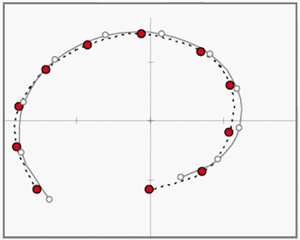Article contents
Distributed vortex receptivity of a swept-wing boundary layer. Part 2. Receptivity characteristics
Published online by Cambridge University Press: 04 December 2020
Abstract

This paper is devoted to an experimental investigation of the distributed receptivity of a laminar swept-wing boundary layer to unsteady freestream vortices with streamwise orientation of the vorticity vector. The experiments were performed on a model of a swept wing with a sweep angle of  $25^{\circ }$ at fully controlled disturbance conditions with freestream vortices generated by a special disturbance source. It is found that the unsteady streamwise vortices are able to provide very efficient excitation of cross-flow instability modes without requiring the presence of any surface non-uniformities. The developed experimental approach is shown to allow us to perform a detailed quantitative investigation of the mechanism of distributed excitation of unsteady boundary-layer disturbances due to scattering of freestream vortices on natural base-flow non-uniformity. This mechanism has been studied experimentally in detail. Part 1 of the present investigation (Borodulin et al., J. Fluid Mech., vol. 908, 2021, A14) was devoted to the description of the experimental approach and the base-flow structure, the method of excitation of fully controlled streamwise-elongated freestream vortices, the results of measurements of structure of these vortices and the experimental evidence of high efficiency of the distributed vortex receptivity mechanism under study. Meanwhile, the present paper (Part 2) is devoted to: (a) theoretical background and definition of the distributed receptivity coefficients and (b) obtaining experimental quantitative characteristics of the distributed vortex receptivity including values of the corresponding receptivity coefficients for their three different definitions as functions of the disturbance frequency, spanwise wavenumber and wave propagation angle.
$25^{\circ }$ at fully controlled disturbance conditions with freestream vortices generated by a special disturbance source. It is found that the unsteady streamwise vortices are able to provide very efficient excitation of cross-flow instability modes without requiring the presence of any surface non-uniformities. The developed experimental approach is shown to allow us to perform a detailed quantitative investigation of the mechanism of distributed excitation of unsteady boundary-layer disturbances due to scattering of freestream vortices on natural base-flow non-uniformity. This mechanism has been studied experimentally in detail. Part 1 of the present investigation (Borodulin et al., J. Fluid Mech., vol. 908, 2021, A14) was devoted to the description of the experimental approach and the base-flow structure, the method of excitation of fully controlled streamwise-elongated freestream vortices, the results of measurements of structure of these vortices and the experimental evidence of high efficiency of the distributed vortex receptivity mechanism under study. Meanwhile, the present paper (Part 2) is devoted to: (a) theoretical background and definition of the distributed receptivity coefficients and (b) obtaining experimental quantitative characteristics of the distributed vortex receptivity including values of the corresponding receptivity coefficients for their three different definitions as functions of the disturbance frequency, spanwise wavenumber and wave propagation angle.
JFM classification
- Type
- JFM Papers
- Information
- Copyright
- © The Author(s), 2020. Published by Cambridge University Press
References
REFERENCES
- 2
- Cited by





